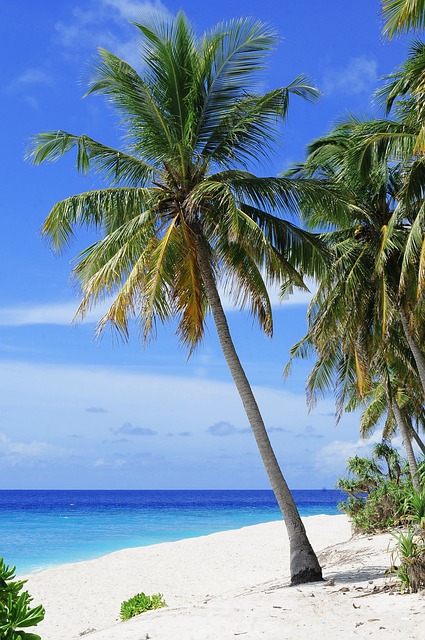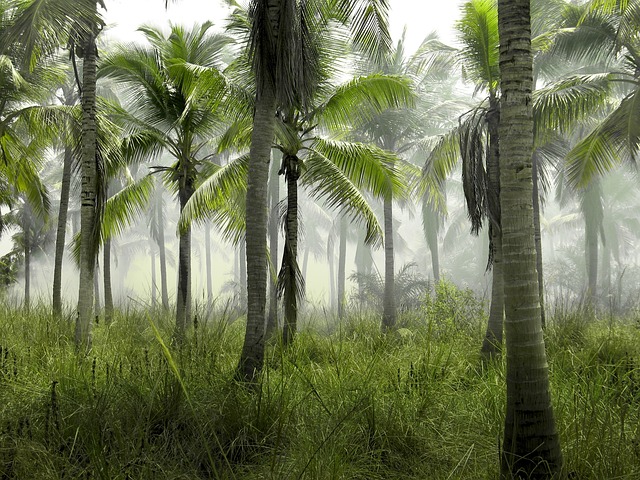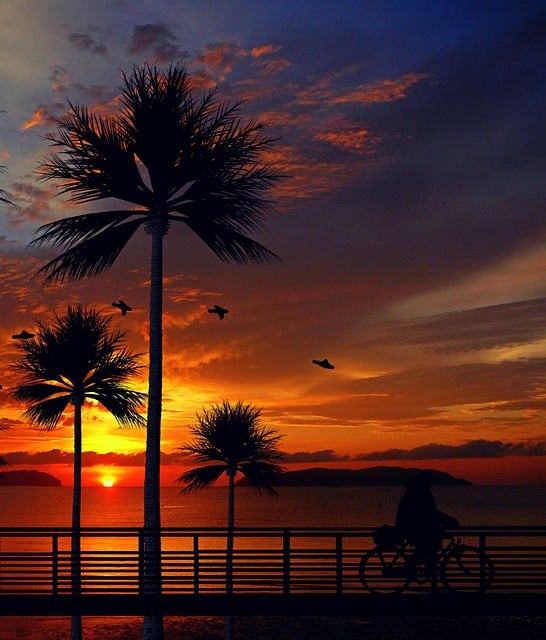The Majestic Palm Tree and Its Significance
Palm trees are pretty popular around the globe, especially in tropical and subtropical regions.
About 180 genera and 2500 species make up the huge plant family known as Arecaceae.
This large number of species means that these trees can be significantly different from each other.

Some have fan leaves while some have feather leaves.
Some grow fruit while some don’t.
Some grow 100 ft tall, while some stay 10 ft small.
Some can only grow outdoors while some can only grow indoors.
It surely offers a range of unique characteristics for plant lovers to pick from depending upon their preferences.
There is also no denying the palm tree’s aesthetic charm.
It brings a distinctive shape with a thin trunk and a canopy of feathery leaves.
Consequently, it is often the most important feature that comes to mind when thinking about tropical places.

South Carolina is home to countless varieties of these palm trees, each having its own unique beauty.
Among the most prevalent species in the area are the magnificent Washingtonia and Queen palms and the hardy Sabal palms.
Thus it is no secret that these trees are a major part of South Carolina’s culture and hold significance for the residents.
Palm Trees and the Local Culture
Thanks to the subtropical climate of Carolinas, Palm trees grow in just about every part of the state and even extend to bordering areas.
With sunny summers and mild winters, the climate offers adequate warmth and sunlight for a wide variety of palm species to flourish.
The palm tree and quarter moon on the South Carolina state flag signify a long history in the state.
The quarter moon symbolizes the state’s independence, while the palm tree stands for success and a large abundance of it in the area.
The design of the flag serves as a reminder of South Carolina’s rich cultural past and highlights the significance of palm trees.

From shopping malls and stadiums to college campuses, these magnificent trees enhance the landscapes of South Carolina and surrounding States. T
hese States also plant and nurture these trees, recognizing their significance as symbols of resilience and cultural heritage.
Landscaping with Palm Trees
Locals in South Carolina hold a deep appreciation for this tree family, which is reflected in their desire for planting them in their homes, parks, and other public places.
These iconic trees have become an important part of the state’s landscape, adding a touch of natural beauty and a sense of tropical ambiance to the urbanized neighborhoods.
Whether it’s a backyard garden, a community park, or a busy street, you’ll often find these trees giving shade to travelers and adding natural beauty.
Solomons Temple Wikipedia
The walls of the sanctuary were lined with cedar, on which were carved figures of cherubim, palm trees, and open flowers that were overlaid with gold (1 Kings 6:29–30). Chains of gold further marked it off from the Holy of Holies. The floor of the Temple was of fir overlaid with gold. The doorposts, of olivewood, supported folding doors of fir. The doors of the Holy of Holies were of olivewood. On both sets of doors were carved cherubim, palm trees, and flowers, all being overlaid with gold (1 Kings 6:15 et seq.)
Whether it is a formal garden or an informal relaxing area, the palm trees are a versatile and graceful addition.
People who love gardening often compliment these trees with other plants as well such as Jasmine, Birds of Paradise, and Bougainvillea plants.

Together, they bring out the best of colors and nature to be enjoyed by anyone who looks at it.
Dwarf vs Standard Palm Trees
The palm tree family can be divided into several categories.
If you are planning to get one for your home then categorizing the species into dwarf and standard size is an ideal starting point.
The general rule is that palm trees that are under 20 feet are considered dwarf while those that are taller than 20 feet are standard-sized.
Dwarf palms are smaller-sized palm species that are well-suited for planting in backyards or even indoors.
Some popular example of dwarf palm is the Cat Palm and European Fan Palm. These dwarf palms are known for their fan-shaped leaves and adaptability to various climates.
These smaller palm species are ideal for homeowners who want to enjoy the beauty of palms without the need for a large space.
On the other hand, standard palms encompass larger palm species that are commonly seen in tropical landscapes.
The Coconut Tree is perhaps one of the most famous standard palms, renowned for its iconic silhouette and versatile uses.
The Date Palm and King Palm are other widely recognized standard palms.
These standard palms can create a tropical haven in larger gardens, parks, or public spaces, providing shade and a sense of exotic beauty.
How To Take Care of Palm Trees
Nurturing trees with adequate knowledge is crucial to keep the plants healthy.
Regardless of whether you have it as a houseplant or for landscaping, making sure some common mistakes are avoided is important. Here are some important care tips to keep in mind:
Watering: The most common mistake that people and gardeners do is that they overwater the palm trees. Different species have different moisturizing needs and it is best to take into account the differences in tree types when watering.
Pruning: Pruning palm trees situated in public places is quite common. We must understand that plants store food and energy in their leaves and cutting them unless they are completely dead can drastically impact their health. Professionals often suggest that no more than 15% of the leaves should be trimmed at a time.
Fertilization: Regular fertilization is necessary for these trees. There are countless palm fertilizers available in the market but going for a balanced blend of nitrogen phosphorus and potassium is always a good idea.
Keeping in mind these basic practices can significantly help your palm tree to stay healthy and grow at an appropriate rate. However, the care requirements vary depending on the species and the local atmosphere.
Palm trees are widely popular in several tropical regions around the world. In the USA, South Carolina is the state most associated with this unique and old family of palm trees. The act of planting and nurturing palm trees is a way for South Carolinians to maintain a strong connection to their culture and history.
Oftentimes, people plant dwarf trees in their backyards while other times people would use them for landscaping. Nevertheless, the presence of palm trees brings a sense of tranquility to both public and private spaces.
Even in colder regions where they may not thrive naturally, palm trees create a comforting and calming atmosphere. With their vibrant green leaves and long fronds, they can create a sight worth seeing.
The palm trees are widely found in tropical and sub-tropical areas and have a close connection to the culture of several places such as South Carolina.
From being a houseplant to a focal point in beautiful gardens, these trees enhance the natural beauty of almost every space.

The use of palm trees in landscaping allows for the creation of different styles and themes, such as tropical, coastal, or Mediterranean-inspired designs.
Their unique appearance adds an exotic touch and evokes a sense of relaxation. Palm trees can be strategically placed to frame views, create privacy, or provide shade, enhancing the functionality and comfort of the outdoor area.
Benefits Of Palm Trees in Your Landscaping
Adds A Tropical Touch: Palm trees are widely associated with tropical vacation destinations. using this tree family for landscaping allows people to replicate the feeling and atmosphere of the most sought-after places.
Wikipedia
Solomon’s Temple
The walls of the sanctuary were lined with cedar, on which were carved figures of cherubim, palm trees, and open flowers that were overlaid with gold (1 Kings 6:29–30
Low Maintenance: Arecaceae family is considered to be low maintenance as they don’t requre frequent watering or fertilization.
Once they have grown, they can withstand the lack of water and also attract very few pests. Thus becoming an ideal choice for gardeners and homeowners.

Several Species: Palm trees have around 2600 species and there are significant differences between them.
Whether you have a spacious garden or a small patio, you can find a palm tree species that suits your available space.
From towering palms that provide shade and privacy to dwarf varieties that thrive in containers, there is a palm tree suitable for every landscape.
Symbolism: Palm trees are not just the state tree of South Carolina, but they also hold great significance in the eyes of residents. They signify growth, longevity, and righteousness and also hold religious values in Christianity.
Enhancing Biodiversity: Trees inherently provide environmental benefits. Similarly, planting palm trees is also a great opportunity to improve local biodiversity. They provide food, shelter, and nesting areas for birds, butterflies, and other local wildlife.
What Do Palm Trees Signify
The prominence of palms in South Carolina is evident in various aspects. For instance, they are often incorporated into holiday traditions, with some households opting for Palm Christmas trees as a unique and local twist on the traditional evergreen.
This cultural significance showcases the deep-rooted connection between palms and the community.
Apart from that, golf course communities, in particular, are often named after palms, emphasizing the connection between leisure, natural beauty, and iconic trees.
Residents also have these trees around them and try to have as much exposure to them as possible.
Finding palm trees at affordable prices can be challenging but they often look for stores like ours to get the best deal for your favorite species.
What Palm Tree Landscapes Has to Offer
Palm trees are crucial when it comes to landscaping in tropical areas. They can be used in a variety of ways to bring out unique and attractive designs and themes. Have a look at a few common ways palms can fit into your landscaping project:
Palms for Shade
These trees are tall and have leaves spread all around them. This makes them a perfect choice for bringing shade to the area. You would have often seen people resting under the coconut tree for shade in movies.
That’s exactly what we are talking about. The tall variation can also live up to 100 years, ensuring that it not just shelters you but also the generations to come.
Palms for Privacy
People in South Carolina often use palms to improve the privacy of their homes. Residents usually go for Areca palm since it is a dwarf tree but is bushy enough to block any view from the outside.
You may check out Areca Palms on our store. There are other ways to plant palms as well to get maximum privacy.
Placing palms strategically along property boundaries or near windows can block unwanted views and create a secluded atmosphere.
Palms as Focal Points
Palms can serve as stunning focal points in a garden or yard. Their tall, slender trunks and crown of fronds are something that immediately catches the eye of anyone around.
People also use lighting techniques to illuminate palm trees at night, further emphasizing their beauty and creating a magical ambiance.
Palms as Architectural Accents
The unique architectural structure of palm trees makes them perfect accents for landscaping designs.
You may use palms to frame an entrance, line a driveway, or carve a pathway, adding a touch of elegance to the overall landscape design. These trees are often found in mansions as they have a sense of luxury to them.
Which Plants Complement Palm Trees
There are several other plants that have proved to be the perfect companion of the Arecaceae family. Since palms are usually tall and bushy, taking up most of the space and focal point, it is necessary to pair them with other colorful and vibrant plants to get the most out of the landscape.
Jasmine vines, with their fragrant flowers, offer an enchanting addition to any landscape. They not only bring vibrant colors and delightful scents but also serve as an excellent way to cover palm trunks.
In addition to jasmine vines, flowers such as white petunias and red begonias provide an array of vibrant colors to that landscape. These flowering plants can be strategically placed in garden beds, borders, or hanging baskets.
To create a well-rounded landscape, the inclusion of shrubs is crucial. Shrubs not only offer a solid foundation for palm trees but also contribute to the overall structure and stability of the landscape. They add density at ground level, creating a layered effect while improving soil stability and preventing erosion.
In Conclusion
Landscaping, especially in regions such as South Carolina, is not complete without palms. Whether it is a small garden or a big yard, these trees are nothing less than a necessity. Check out our store and decide which palm will suit your landscape!